I mentioned several posts ago that we have had an incredible number of hummingbirds this year and I have been snapping away trying to get shots of these very fast, very tiny birds.
Like all hummingbirds, ruby-throats are precision flyers with the ability to fly full out and stop in an instant, hang motionless in midair, and adjust their position up, down, sideways, and backwards with minute control. They dart between nectar sources with fast, straight flights or sit on a small twig keeping a lookout, bill waving back and forth as the bird looks around. Male Ruby-throated Hummingbirds aggressively defend flowers and feeders, leading to spectacular chases and dogfights, and occasional jabs with the beak.
~*~
We have three feeders ~ each positioned to be easily seen from inside the house.
One is on the front porch, one right outside the side door and one just outside the kitchen window.
I keep the feeders filled with sugar water that I make by bringing
1 cup of sugar and 4 cups of water
just to a boil so that the sugar is completely dissolved.
When cooled I bring in the feeders, empty and wash them, and refill with the fresh nectar.
The hummers wait for their feeders to be returned so they can again get their fill.
Can you see the hummingbird in this photo?
it is hard to see her…
There she is. The female Ruby-Throated hummer does not have the iridescent red band around the neck as does the male.
Measurements
Both Sexes
Length
2.8–3.5 in
7–9 cm
Wingspan
3.1–4.3 in
8–11 cm
Weight
0.1–0.2 oz
2–6 g
Happy to have the feeder returned, this little bird can barely wait for me to hang it on the hook. See her flying in from the left of the photo, right at the roof edge?
She didn’t land on the feeder while I was holding it but she came very close.
Migration
Medium to long-distance migrant. Most Ruby-throated Hummingbirds spend the winter in Central America, and most get there by flying across the Gulf of Mexico. Some birds stay in North America along the Gulf Coast and at the tip of Florida; these are usually birds from farther north rather than birds that spent the summer there.
Cool Facts (Source)
- The Ruby-throated Hummingbird beats its wings about 53 times a second.
- The extremely short legs of the Ruby-throated Hummingbird prevent it from walking or hopping. The best it can do is shuffle along a perch. Nevertheless, it scratches its head and neck by raising its foot up and over its wing.
- Scientists place hummingbirds and swifts in the same taxonomic order, the Apodiformes. The name means “without feet,” which is certainly how these birds look most of the time.
- The Ruby-throated Hummingbird does not show a strong preference for any particular color of feeder. Instead, it prefers specific feeder locations.
- Ruby-throated Hummingbirds prefer to feed on red or orange flowers. Like many birds, they have good color vision and can see into the ultraviolet spectrum, which humans can’t see.
- Ruby-throated Hummingbirds normally place their nest on a branch of a deciduous or coniferous tree; however, these birds are accustomed to human habitation and have been known to nest on loops of chain, wire, and extension cords.
- Ruby-throated Hummingbirds are eastern North America’s only breeding hummingbird. But in terms of area, this species occupies the largest breeding range of any North American hummingbird.
- Male Ruby-throated Hummingbirds don’t stick around long. Pairs are together long enough for courtship and mating – just a matter of days to weeks. Then he’s off on his own, and may begin migration by early August.
From Wikipedia:
Ruby-throated hummingbirds are solitary. Adults of this species typically only come into contact for the purpose of mating, and both males and females of any age aggressively defend feeding locations within their territory. The aggressiveness becomes most pronounced in late summer to early fall as they fatten up for migration. This is important because, as part of their migration, they must fly across the Gulf of Mexico – a feat which long confounded scientists, as a 500-mile, non-stop flight over water would seemingly require a caloric energy that far exceeds an adult hummingbird’s body weight of 3 grams. However, researchers discovered the tiny birds can nearly double their body mass in preparation for their Gulf crossing. The additional mass, stored as fat, provides enough energy for the birds to achieve this amazing flight.
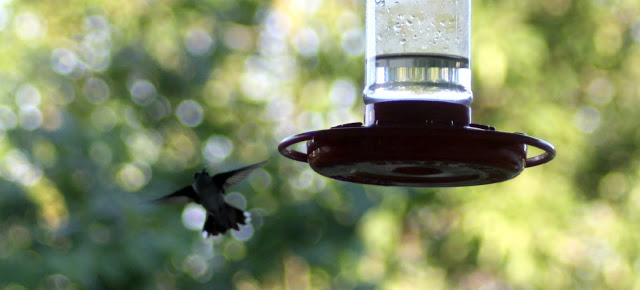

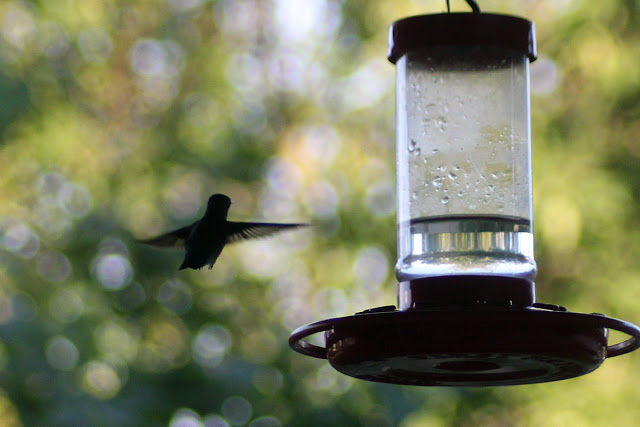

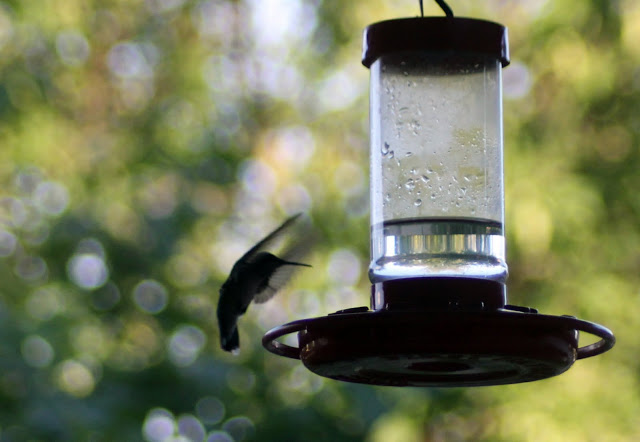

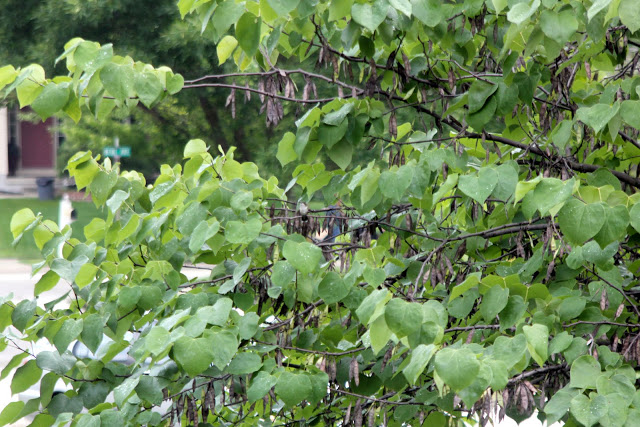





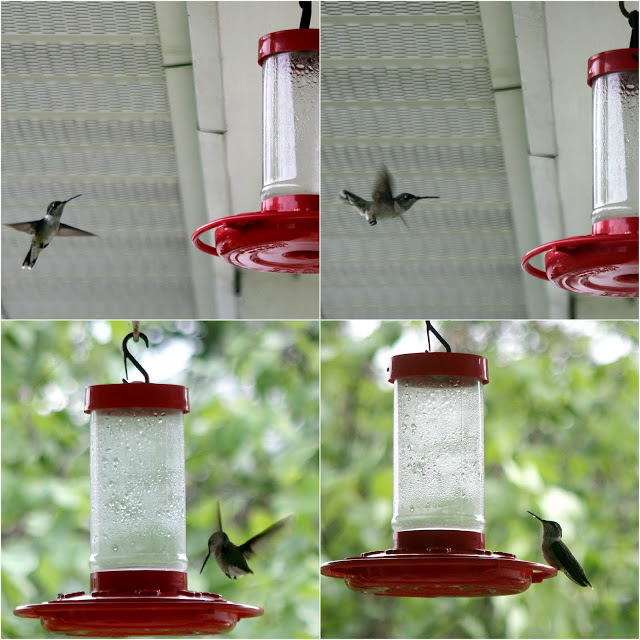
I love hummingbirds and have learned a lot about them just now. Thank you!
What wonderful pictures! I used to have hummingbird feeders on my porches but they made me feel guilty because I didn't always keep them filled (they were emptied so fast!) So I gave my feeders away and just plant hummingbird-friendly plants now. I don't have quite as many birds but I have time now to enjoy the ones I do have!
Sherry @ A Happy Valentine
Wonderful photos. I saw on another blog where they put the hummingbird food in their hand and the it actually landed right there. I thought for sure that one was going to fly right to the feeder while you were holding it
My goodness! And we don't have ANY this year-now I know where they all are!!! Yours are just amazing. I make my own "juice" too and put a drop or two of red food coloring in it. Maybe they like it better when it is clear!;>)
Love the photo of you hanging the feeder and the hummer coming in to land! xo Diana
I love to watch hummingbirds! We have one or two that 'work' our hanging fuschia outside the sliding doors to the patio. Whenever he or she wants to feed on the fuschia early in the morning and I'm sitting in the hot tub nearby – he/she comes near my head and beats the wings in a disturbed motion that clearly tell me I'm an inconvenience!
~Adrienne~
Wow, you got some wonderful photo's! They are very hard to capture in pics. I also make the same sugar water mix. I wash and re-fill mine about every 10 days and I scrub with hot soapy water because I found out from another blogger that any mildew can infect their little beaks:(
Ours are fighting too, it's really entertaining to watch! They were getting into it big time yesterday, it almost seems like they have fun! Thank you so much for all the hummingbird info:)
Hummingbirds are absolutely fascinating! And look like winged jewels!
Great photos!
Thanks for dropping in for a little visit!
;~P
Such tiny little birds and so very entertaining. Thanks for sharing your pics. When I worked in the flower garden, and wore a brighly colored shirt, they would often fly right up to me!
M. Lane
Hummingbirds are my favorites. We have quite a few this year as well and it is quite entertaining watching them protect "their feeders" We have tried putting several around the yard but there always seems to be one male that thinks they are all his. Pictures are great
These photos are wonderful. I have just learned a lot about these amazing birds from your post. Thanks. Hugs, Deb=^..^=x4